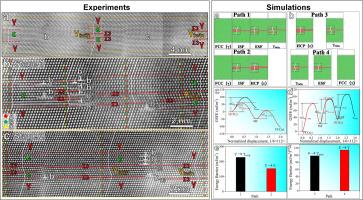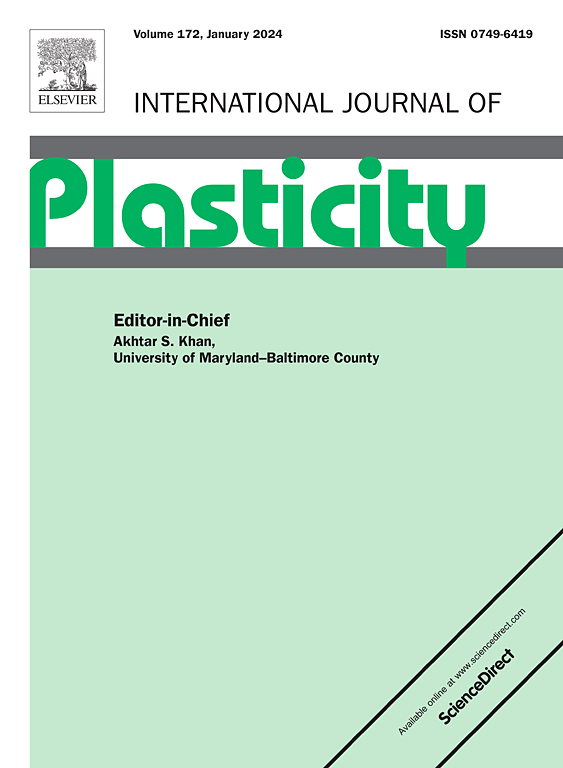亚稳成分复杂合金中位错驱动ε→γ孪晶逆转的原子尺度机制:来自实验和分子动力学模拟的见解
IF 12.8
1区 材料科学
Q1 ENGINEERING, MECHANICAL
引用次数: 0
摘要
介稳面心立方(FCC)合金中ε→γ孪晶的逆转过程由于其复杂的位错介导性质而仍然知之甚少。在本研究中,我们通过实验和计算相结合的方法揭示了Co34Cr23Fe25Ni18 wt.%亚稳态复合合金(CCA)中这种转变的原子尺度机制。准原位电子背散射衍射(EBSD)、透射电子显微镜(TEM)和原子分辨率成像显示,ε-马氏体向γ纳米孪晶的转变不是由肖克利部分位错(SPD)滑移主导的常规机制介导的。相反,它通过包括spd、完全位错和Frank偏位的协同序列以及边界松弛过程进行。沿<;001>;方向诱导形成ε-马氏体,退火后恢复为γ纳米孪晶。分子动力学模拟进一步阐明了能量学,表明ε→γ孪晶相变在高温下更有利于热力学。模拟还强调了层错能(SFE)在决定ε相稳定性和孪晶形成动力学中的关键作用。我们的发现为亚稳合金中位错辅助孪晶逆转建立了一个新的机制框架。它不仅推进了对转化介导孪晶的基本理解,而且为微结构工程提供了战略见解。通过利用位错相互作用和转化途径,这种方法为设计具有优越强度-延性组合的先进材料提供了途径。本文章由计算机程序翻译,如有差异,请以英文原文为准。


Atomic-scale mechanisms of dislocation-driven ε→γtwin reversion in metastable compositionally complex alloys: insights from experiments and molecular dynamics simulations
The ε→γtwin reversion process in metastable face-centered cubic (FCC) alloys remains poorly understood due to its complex, dislocation-mediated nature. In this study, we uncover the atomic-scale mechanisms governing this transformation in a metastable compositionally complex alloy (CCA) with Co34Cr23Fe25Ni18 wt.% through a combined experimental and computational approach. Quasi-in-situ electron backscatter diffraction (EBSD), transmission electron microscopy (TEM), and atomic-resolution imaging reveal that the reversion from ε-martensite to γ nanotwins is not mediated by conventional mechanisms dominated solely by Shockley partial dislocation (SPD) glide. Instead, it proceeds via a cooperative sequence involving SPDs, full dislocations, and Frank partials, alongside boundary relaxation processes. Uniaxial compression along the 〈001〉 direction induces ε-martensite formation, which reverts to γ nanotwins upon annealing. Molecular dynamics simulations further elucidate the energetics, showing that the ε→γtwin transformation is thermodynamically favored at elevated temperatures. The simulations also highlight the crucial role of stacking fault energy (SFE) in determining ε phase stability and twin formation kinetics. Our findings establish a new mechanistic framework for dislocation-assisted twin reversion in metastable alloys. It not only advances the fundamental understanding of transformation-mediated twinning but also provides strategic insights for microstructural engineering. By leveraging dislocation interactions and transformation pathways, this approach offers a pathway to design advanced materials with superior strength–ductility combinations.
求助全文
通过发布文献求助,成功后即可免费获取论文全文。
去求助
来源期刊

International Journal of Plasticity
工程技术-材料科学:综合
CiteScore
15.30
自引率
26.50%
发文量
256
审稿时长
46 days
期刊介绍:
International Journal of Plasticity aims to present original research encompassing all facets of plastic deformation, damage, and fracture behavior in both isotropic and anisotropic solids. This includes exploring the thermodynamics of plasticity and fracture, continuum theory, and macroscopic as well as microscopic phenomena.
Topics of interest span the plastic behavior of single crystals and polycrystalline metals, ceramics, rocks, soils, composites, nanocrystalline and microelectronics materials, shape memory alloys, ferroelectric ceramics, thin films, and polymers. Additionally, the journal covers plasticity aspects of failure and fracture mechanics. Contributions involving significant experimental, numerical, or theoretical advancements that enhance the understanding of the plastic behavior of solids are particularly valued. Papers addressing the modeling of finite nonlinear elastic deformation, bearing similarities to the modeling of plastic deformation, are also welcomed.
 求助内容:
求助内容: 应助结果提醒方式:
应助结果提醒方式:


